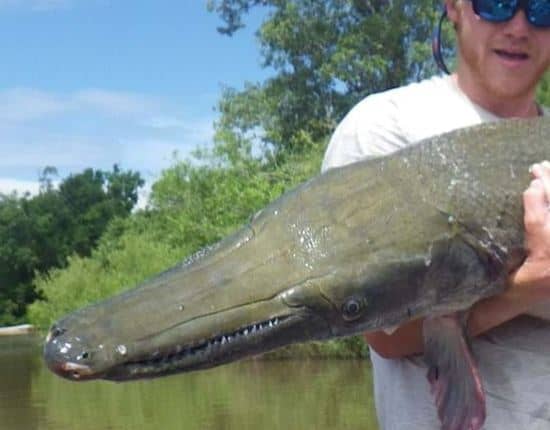August 26, 2020
By: Staff Report, FWC Conservation
PENSACOLA, Fla. – Finding alligator gar (Atractosteus spatula) can be a challenge, but it’s one biologists with the Fish and Wildlife Research Institute (FWRI) are taking on to learn more about the population of the fish in Florida. Alligator gar have historically resided in rivers and brackish waters throughout the southeastern U.S. from the Florida Panhandle – from the Apalachicola River west to the Perdido River – to Texas and Mexico. Since the mid-1900s, alligator gar numbers have declined, leaving populations in only half of the 14 states they once inhabited. The FWC acknowledged this in 2006, prohibiting harvest of alligator gar for all but scientific purposes.

Since 2010, FWRI researchers have been tagging alligator gar in the Escambia River to learn more about their movement and habitat use. Using large-mesh gill nets, researchers collect adult alligator gar and fit them with telemetry tags before releasing them back into the river. These tags transmit information through radio and sound signals, allowing researchers to track each individual’s location for about two years
Three years into the study, researchers have tagged 22 alligator gar ranging from 11 pounds to a state record 132 pounds; tagged fish average 60 pounds. Researchers are trying to identify what habitats these fish prefer, how far they travel and whether they return to the same location over time. Preliminary tracking data indicate alligator gar are highly mobile and can travel more than 40 miles in a single week
The data also reveal their movement and habitat use varies by season. In winter, the tagged fish tend to reside in a slough – a cove off the main river with no current – and move very little. As the season changes to spring, they begin traveling the river’s main channel but return repeatedly to the slough. Only in late spring did the gar venture from their home-base slough and begin cruising. Biologists recorded alligator gar moving as far north as the Alabama state line and as far south as Escambia Bay during this time.

No population data for alligator gar in Florida currently exist. However, data from this tagging study are helping biologists develop a strategy for estimating the population size of alligator gar, first in the Escambia River, then possibly in other rivers in northwest Florida’s coastal plain. If the numbers are promising, resource managers could revisit harvest regulations. FWRI biologists will continue to research the population status of alligator gar in Florida, and the more we learn about this species, the more we can focus conservation efforts to protect it.
To learn more about Alligator Gar and Florida Wildlife, visit: https://myfwc.com/research/freshwater/
